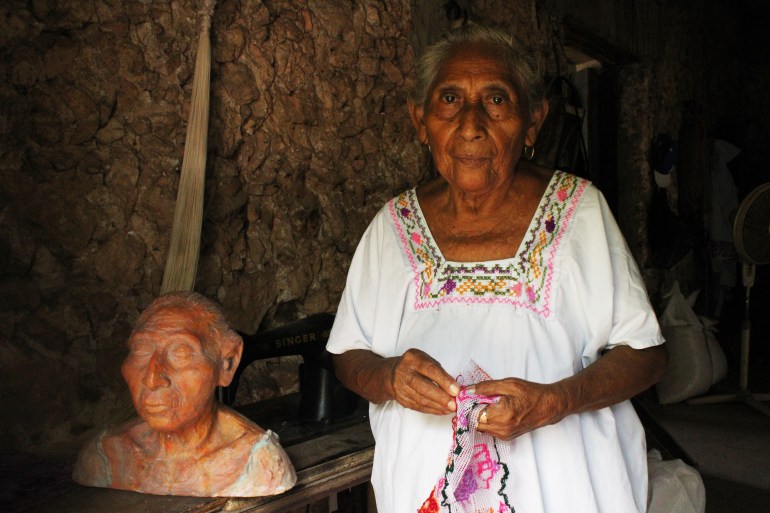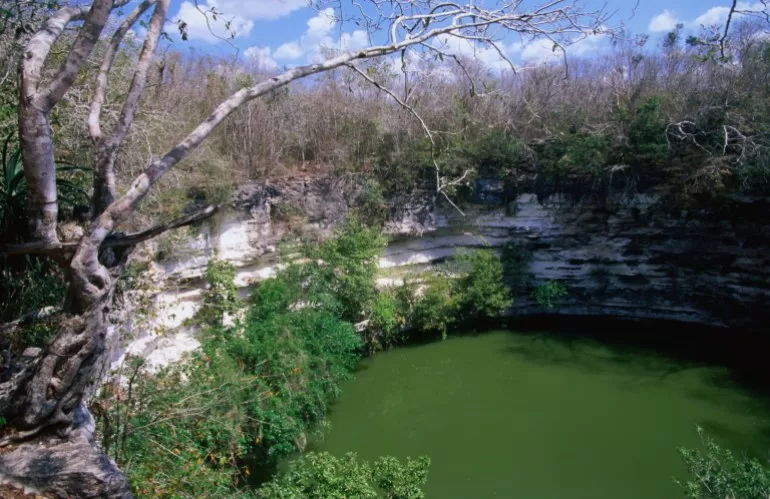Dzan, Mexico – Surrounded by dense jungle and beneath intertwining canopies of towering trees, Luis May Ku, 49, trudges ahead through shoulder-height bushes searching for a rare plant. The oppressive 40-degree Celsius (104 Fahrenheit) heat dulls the senses, and the air, thick with humidity, clings to our skin, causing beads of sweat to form and trickle down.
After scouring the thickets, May, an Indigenous Maya ceramicist, stumbles upon a shrub similar in shape and texture to others around him, but insists this one is special. He touches the soft, sprawling leaves and tells me it is wild ch’oj (“indigo plant” in Mayan, anil in Spanish) – or Indigofera suffruticosa – which is a key ingredient to create the revered Maya blue pigment.
“It took years before I found it – indigo – and most people from Yucatan believed it to be extinct on the peninsula,” May says with a pensive look, lifting his sombrero made from interwoven huano palm leaves to wipe his brow with the back of his hand.
“Chokoj (hot)!” I say to him in my limited command of Mayan as we crouch behind the metre and a half (5-foot) high ch’oj bush to escape the relentless, blistering sun. He turns to me with kind eyes and offers me water from his bottle.
“The Yucatan Peninsula is going through its worst drought in decades,” he says. “Let’s rest, and I’ll tell you how I recreated Maya blue.”
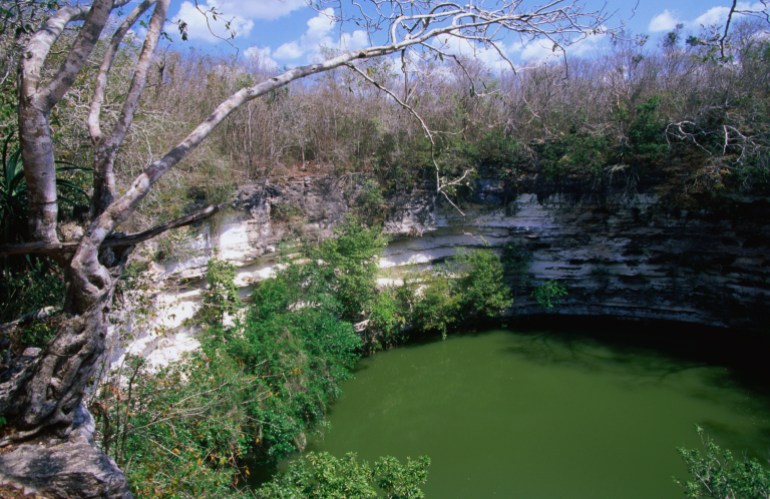
Maya blue: the colour of ritual
The colour of the iconic dye is akin to a clear blue sky or the turquoise of the nearby Caribbean Sea.
It was used to paint pottery, sculptures, murals, jewellery, clothing, altars and, chillingly, the human beings the ancient Maya offered to their gods, to garner favour. According to Spanish Franciscan friar Diego de Landa Calderon – most famous for his zeal in destroying Maya codices – the Maya painted human beings before forcing them onto an altar and cutting out their beating hearts.
Other victims, cast into the Cenote Chenku or Sacred Well (cenotes are interconnected, submerged limestone caves) at Chichen Itza, were similarly covered in blue. A clear sky during a drought was a sign for priests to pick their next victim and paint them in the same colour to sacrifice to the rain deity, Chaak, believed to live in Xibalba – the Maya underworld – beneath the cenotes. The priests hoped this would bring rain to provide a bountiful harvest for their crops.
When American archaeologist Edward Herbert Thompson dredged the Sacred Well in the early 20th century, 127 skeletons were recovered, among other objects. He also found several metres of blue silt, which later studies suggest was Maya blue that had washed off sacrificed victims and ornaments.
The bright azure colour can still be seen among the ruins at the world-famous archaeological site of Chichen Itza in Yucatan on murals more than 800 years old.
Only a handful of blue pigments, such as lapis lazuli or Egyptian blue, were created by ancient civilisations. Still, these were predominantly dyes or minerals, while Maya blue required a chemical combination of organic and inorganic substances. Before synthetic versions of blue pigment arrived during the Industrial Revolution, the colour was exceedingly rare and often more expensive than gold in Europe. The semiprecious lapis lazuli stone originated in the mountains of Afghanistan and was only accessible to the wealthy. Yet, in the New World, blue pigment was plentiful and thrived.
When the Spanish arrived in the 15th century, they exploited Maya blue, along with all the treasures they stole from Mesoamerican civilisations. The Spanish controlled the prized colourant until the late 17th to early 18th centuries when synthetic substitutes began to arrive. Common knowledge of Maya blue then disappeared until its rediscovery in the 20th century.
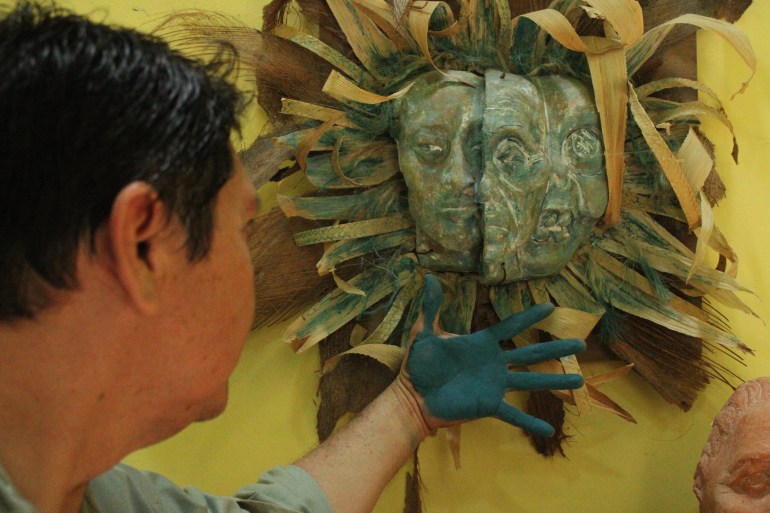
Technological and artistic marvel
In 1931, American archaeologist HE Merwin first found “a new pigment” on murals within the Temple of The Warriors at Chichen Itza. It was given the name “Maya blue” a few years later (1942) by American archaeologists RJ Gettens and GL Stout. Research paused during World War II, and it was not until the 1950s that powder diffraction analysis revealed the Maya blue pigment had been made by mixing clay, palygorskite (a rare fibrous clay) and indigo. In 1993, Mexican historian and chemist Constantino Reyes-Valerio published a recipe to recreate the colour using palygorskite, montmorillonite (a soft clay) and indigo leaves.
Modern-day scientists value the mysterious paint because its unique resilience to the elements has kept it in near-perfect condition on pre-Columbian murals, artefacts and codices, even a millennium later.
“The pigment has received considerable attention because of its peculiar nature as an organic-inorganic hybrid material, its characteristic palette, ranging from a bright turquoise to a dark greenish blue, and its enormous resistance to attack from acids, alkalis, organic reagents and biodeterioration,” says Maria Luisa Vazquez de Agredos-Pascual, a professor of art history at the University of Valencia, Spain. She says the aforementioned characteristics make Maya blue one of the most important technological and artistic achievements of the Maya civilization.
Vazquez adds that although Maya blue was identified as a new dye in 1931, it took scientists a long time to understand the formula, and studies are continuing.
“It was not easy because it was a hybrid pigment, in between organic and inorganic, and detecting organic components is complicated,” she tells me, citing improvements in chromatography and other scientific analysis of components that allowed her and her team to further define the composition of Maya blue. Her research determined that the complex chemical process of creating the pigment resulted in two distinct colourants: indigotin and dehydroindigo.
“Maya blue required an intricate method of manufacturing synthesis of various substances and elements, such as extracting dye from ch’oj before precipitating it onto special clay called palygorskite,” says Vazquez, who spent two years in Mexico completing a thesis on optimising electrochemical techniques to identify pre-Hispanic organic colourants, which focused on the indigo plant.
“The indigotin – extracted from indigo – that sticks to the clay stabilises by heating it in an oven, producing a second colourant called dehydroindigo, which makes Maya blue,” she adds.
According to Vazquez, the scientific community benefits greatly from Indigenous peoples who “maintain ancestral knowledge”.
“They are the guardians of all these traditions relative to their ancestors, and it is vital to assist scientific development,” she says. “It is a connection between past and present. These ancient traditions are important, and I hope they are not lost.”
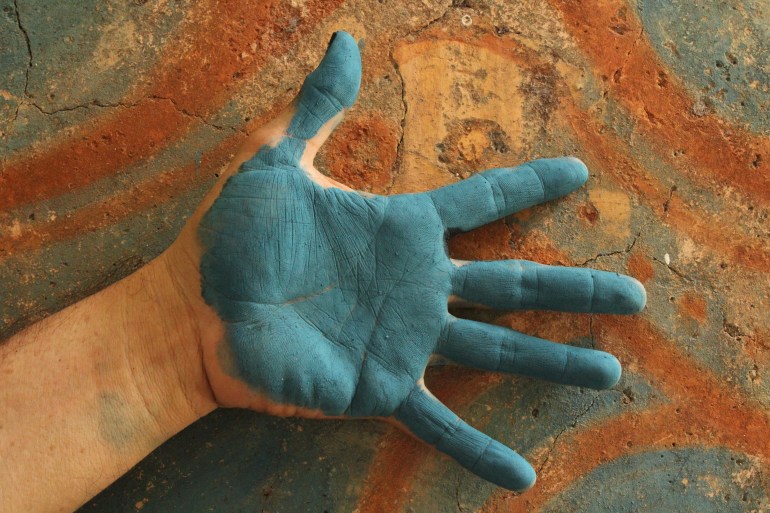
‘The Pearl of the South’: Where the journey began
May was born in Dzan, a village of 6,000 people in the western part of Yucatan about 100 kilometres (62 miles) south of the state capital city, Merida. Most of the peninsula is flat and pocketed with cenotes formed in the aftermath of the cataclysmic meteor that wiped out the dinosaurs. Yet in the municipality of Ticul, which includes Dzan, the land rises somewhat, giving way to the Puuc (“hills” in Maya) region, which has been inhabited since around the 7th century BC.
Several important pre-Columbian Maya cities dot the area, such as the World Heritage Site of Uxmal, an ancient Mayan city with beautiful Puuc-style architecture. The buildings in the ruins have smooth, vertical walls with features such as columns, elaborate friezes, decorated masks and curved snakes, mostly representing the rain god, Chaak, and the feathered serpent deity, Kukulkan, respectively.
The region remains famous today because of its high-quality pottery and clay sculptures, especially the town of Ticul, nicknamed “The Pearl of the South”, 5km (3.1 miles) from Dzan. The area is also a source of palygorskite – found in caves – which some potters use to grind and mix with other clays to make pottery more durable. Here, May cut his teeth in ceramics as a student among some of the most renowned artisans in Mexico and eventually began his journey to recreate Maya blue.
“I dreamt of working as my ancestors did with clay and natural pigments,” he says, tapping a finger on his temple. He reminds me that, like most people in his village, his mother tongue is Maya, and emphasises that he is proud to work like his forefathers in creating Maya blue.
May was 17 years old when he started sculpting wood while studying Maya Culture at the Autonomous University of Yucatan, taking inspiration from Maya architecture around his region. One of his passions was capturing faces with distinct Maya features. About 20 years later, he followed in the footsteps of ceramicists from Ticul and began sculpting with clay and learned from other ceramicists about adorning pottery with organic pigments such as red and white.
However, he was also fascinated to learn that they also used synthetic pigments – like blue. On a visit to the Maya ruins in Bonampak, Chiapas, he was captivated by murals painted with a beautiful turquoise colour. May discovered that the sky-blue pigment was held sacred by his ancestors and used during rituals. After questioning his colleagues further, he learned that the knowledge needed to create this colour in its traditional form had been lost in Yucatan, leading him towards a path of rediscovery of ancient techniques.
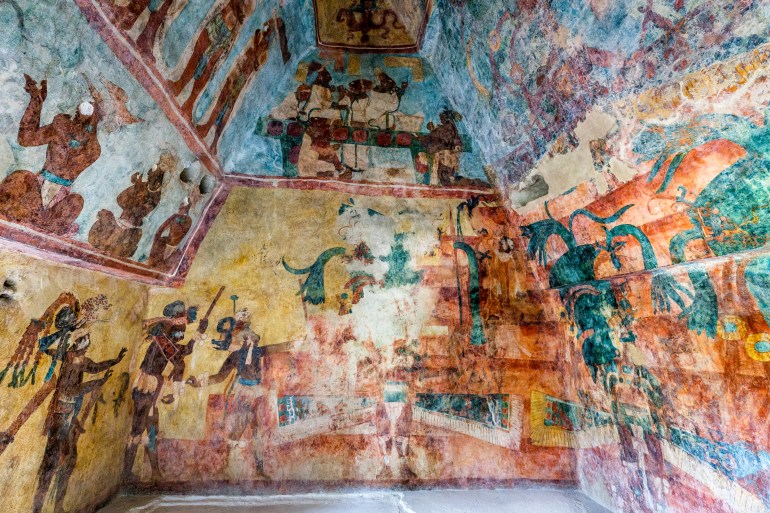
Cracking the blue code
At first, he read through any old Spanish books and manuscripts he could find and learned some of the science behind recreating Maya blue. However, most research about the pigment is written in English, which he does not speak. In 2018, May started travelling around the state searching for information, including the Maya name for indigo. About three years later, when speaking with village elders, he found a clue.
“All knowledge of ch’oj had passed down through generations as a medicinal plant or to whiten clothes, but its use in Yucatan as a pigment was, seemingly, lost forever,” he says. May learned from an elder that indigo would be left in a tub of water overnight, then stirred before soiled clothes were swirled in the water for a short period to whiten them. Left too long in the mix, they would turn blue.
“It was a true feeling of ‘kiimak ool’ (happiness)” May recalls, when the elder revealed that the Mayan name of the indigo plant was “ch’oj”.
This allowed him to gather information from Maya-speaking village elders who could point him in the right direction. It turns out the main ingredient for Maya blue was right under his nose.
At the time, May worked as a primary school teacher at the Municipal Cultural Centre in Coba, Quintana Roo. He remembered that his students used shrubs as goalposts for soccer games in the centre’s back garden. Those shrubs, he realised, were indigo plants.
He asked the caretaker and his close friend, Don Justino, to help him “rescue” the plants. Justino, whom May says uses the plant’s leaves for traditional medicine to treat severe stomach pain, was happy to surround the shrubs with fencing to protect them.
May collected and planted the ch’oj seeds, and grew 30 more shrubs in a nearby plot of land borrowed from the cultural centre. In November 2019, with the help of several assistants from Coba, he prepared his mixture of ch’oj and palygorskite clay in a large concrete vat filled with water. Initially, only white foam floated to the surface, but after stirring the mixture for an hour, the water started to turn blue, sparking cheers from the group. However, May saw the colour was still too pale and needed further refinement to achieve an authentic Maya blue.
“In Coba, we had managed to extract a blue tint from the plant, but it was in my lab [a spare room he converted to test his mixtures] back home in Dzan and using a clay furnace I constructed, similar to the traditional ones in Ticul used by ceramicists, that I found the missing piece,” he says.
“I experimented with various natural additives. I tried freezing ch’oj, letting it decay – it took many failed attempts before I finally cracked the code.” But then the moment came when May watched the colour shift from soft blue to vibrant turquoise. He repeated the process and produced the same hue each time. He had successfully recreated the elusive colour.
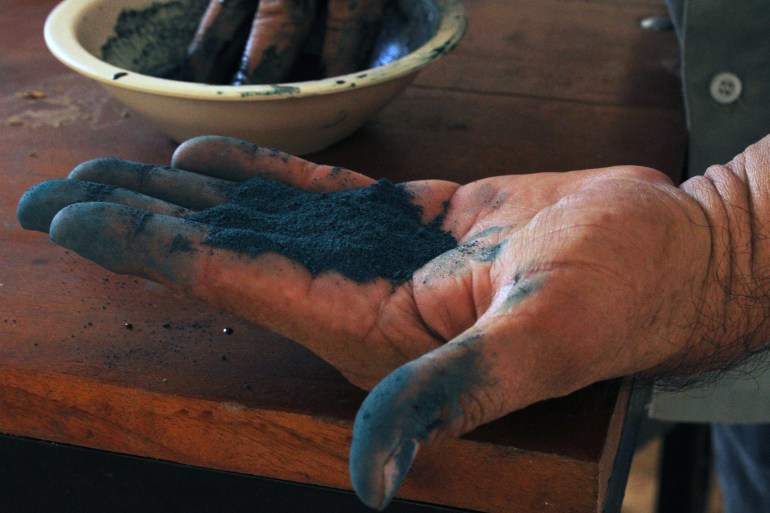
Scientific acknowledgement
On January 9, 2023, May announced on social media that researchers in Italy and Mexico had validated his formula. It was the first time the world had seen Maya blue made with traditional methods in Yucatan for almost two centuries.
David Buti, a researcher at the Institute of Heritage Science of the National Research Council in Perugia, Italy, and Rodolfo Palomino Merino, a professor of physics and mathematics at the Autonomous University of Puebla, Mexico, sent him PDFs with scientific breakdowns of their analyses. Merino’s work came through first in August 2022, with a 95 percent probability that May’s formula was genuine. In 2023, Buti’s analysis verified that it was 100 percent Maya blue. Both academic institutions confirmed that his samples, which contained palygorskite, calcium carbonate and indigo, caused an “intercalation between the indigo molecules” – a chemical reaction – resulting in an authentic Maya blue.
“I was ecstatic,” May says. “My ancestors used Maya blue exclusively in ceremonial practices, and even then, it was in limited supply. It was the colour of the gods, and only the elite were permitted to use it.”
“As a child, my father and grandfather taught me that consistent hard work pays off. Never giving up and trying your best, even if you do not succeed, are typical Mayan values,” he adds.
To make Maya blue, May places ch’oj leaves in alkaline water – using lime or ash – for 24 hours in a concrete vat at his home. Then the mixture is strained and palygorskite clay, collected from nearby caves, is positioned at the bottom of the vat to absorb the tint. After the resulting blue clay is baked in an oven at about 250 degrees Celsius (480F), it is then ground into a fine powder and inserted inside a small flask, ready to sell.
In 2021, May began selling his Maya blue product commercially to artists and businesses. Then, in late 2023, he moved from Coba to Dzan to be closer to his family and converted his family milpa (farm) into a larger ch’oj plantation. A good harvest produces approximately 10kg (22 pounds) of pigment annually.
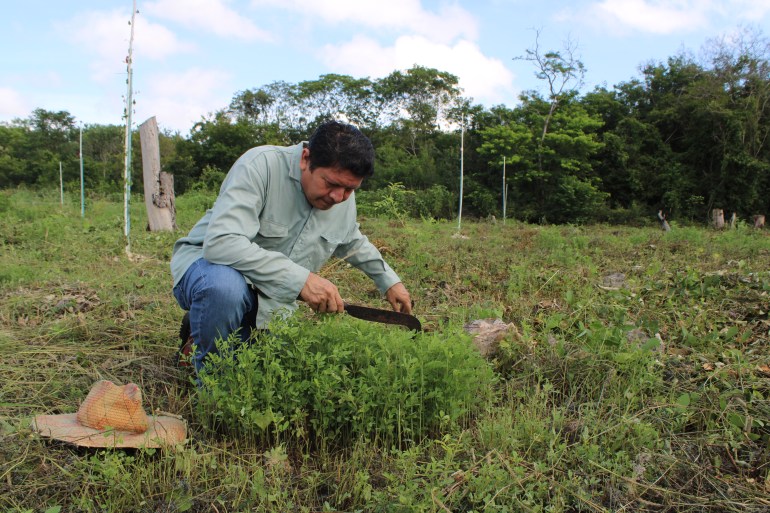
Inspiring future generations
As the late afternoon sun fades, we walk a few hundred metres towards May’s plantation. He points to three young men busily cutting weeds with sharp sickles. He says ch’oj is fragile and suffers from competition against other species that grow more quickly, blocking out sunlight and capturing most of the rainwater. That is why the workers create space for ch’oj, which can reach more than two metres high, to grow without impediment – weeds grow fast in the Yucatan jungle during the rainy season (June until late October).
University student Benjamín Tenreiro Poot, 23, from El Naranjal, Quintana Roo is one of those workers. “Maya blue represents my roots, and I’m delighted to be involved in a project that pays tribute to Maya heritage,” he says enthusiastically, taking a break and resting his sickle on his knee.
He was struggling to pay for his alternative tourism studies at the Maya Intercultural University of Quintana Roo when his professor, Guillermo Talavera, suggested May’s project. Poot beams as he turns towards May, and says his aim after graduation is to promote Maya blue. “I think it is important that people from all over the world are aware of this amazing pigment and its history.”
May tries to conceal his pride, saying that his goal is to inspire younger generations to preserve Maya heritage.
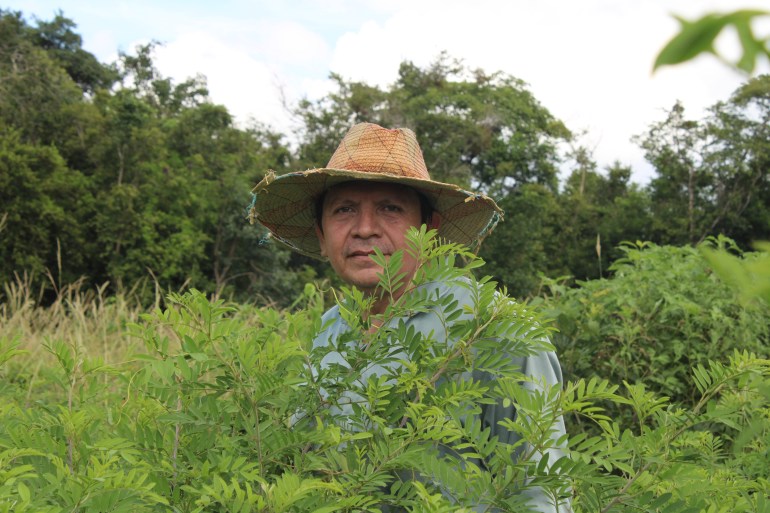
Maya cultural pride
When we return to Dzan later in the day, May stops at a small shop to visit a family friend, Catalina Kankub Hab, whose face he sculpted in 2018 using Maya blue pigment.
I bow my head to enter through a small door, and a woman dressed in a huipil (a traditional white garment embroidered with colourful flowery design) approaches us. May asks to see the sculpture he made for her. She points above a wardrobe, saying in an apologetic tone that she keeps it there out of the reach of her grandchildren. May brings it down. There’s a strong resemblance between the sculpture and our host.
“It raises my spirit when I look at it,” says Catalina Kankub Hab with an endearing smile. “Maya blue is a beautiful colour, and it is a wonderful thing that Luis was able to rediscover it.”
Despite his significant discovery, May’s work remains a solo project, without affiliation or funding from national authorities – his only financial aid was a one-year grant in 2021 from the Santo Domingo Centre of Excellence for Latin American Research department of the British Museum in London. He chooses not to patent his recipe because it would require publicising his unique formula, and people or corporations might use it to create other versions. However, May’s discovery is covered by the World Intellectual Property Organization (WIPO) and the United Nations Declaration on the Rights of Indigenous Peoples.
“I would happily share my formula had I received adequate support from Mexican authorities,” he says. But then his shoulders sink as he explains that the Mexican government used him as propaganda during the construction of the Maya Train: a 1,554km-long (966-mile) intercity railway in Mexico that traverses the Yucatan Peninsula.
When May posted the results of his formula on social media, government officials coaxed him to take part in a promotional video for the Maya Train. He also attended a photo shoot with several scientists from the Autonomous University of Merida (UNAM) and was promised financial aid to support his project. However, he claims to have not received any funding from anyone nationally.
“Mexican bureaucracy makes it so hard for people like me to succeed, yet it takes a piece of my success with every step I take,” says May.
“I hope people understand that I have nurtured this project with my own sweat and blood and would prefer Maya blue to remain in the hands of Indigenous Maya people.”
